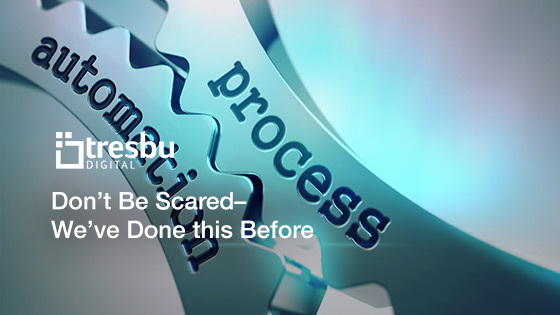Low-Code from Mendix Is the Latest Chapter in Evolutionary History
Low-Code and especially Mendix are the talk of both the tech industry and the business world right now. As organizations learn more about it, many are wary of adopting something that appears so new. But they needn’t worry. Not only has Low-Code been around most of this century, it is also just the latest example of mechanisms we’ve seen at work since the beginning of computer programming–and of history itself.
Low-Code is the product of two phenomena that throughout time have guided the evolution of both humans and the tools we use: continual improvement and specialization. Continual improvement explains how a simple ox-powered plow that pretty much anyone could build (but only a few were strong enough to use) eventually morphed into a complex, diesel-powered, automated plow that requires specialists to build (but nearly anyone can operate). It’s also why our tools are always becoming more powerful, more precise, and ultimately easier to use.

The second phenomenon is specialization. Specialization is why so many of us buy clothes and food instead of making or growing it ourselves: it’s just more efficient for people with specific skills and toolkits to dedicate themselves to honing those skills and toolkits, then exchange their output with others with different specialized skills and toolkits. Without specialization, all of us would have to learn to produce everything from food to manufactured goods ourselves.
Eventually, we humans improve our tools until they almost operate themselves, at which point the need for skills specialization significantly decreases until nearly everyone can use the tools effectively.
And the Cycle Begins Again
Software development has also followed this cycle. Decades ago, the first software developers wrote in machine code, which spoke directly to the CPU to get work done. Because writing code that speaks directly to a CPU is a meticulous undertaking requiring substantial training and a high degree of skill, all computer programming required a lot of specialization. So business software development was divided into two clearly defined groups: programmers who wrote code and business people who defined the business processes that programmers automated. These two sides of business software creation came together only through the mediation of business and systems analysts.
Over the years, however, we improved programming languages. These new higher-order programming languages abstracted away the lower layers of the application development stack, making it quicker and easier to write code. This made it easier for non-programmers to participate in software development. It also had the added benefit of freeing programmer time to study the problems of complex business logic and thus become more familiar with the needs of their internal clients–and better able to meet them.

Eventually, we improved programming languages to the point that they became more like human languages. This meant business process experts could talk directly with programmers and be understood. With the new easier-to-learn programming languages, the business process experts could even learn to code a bit. These advanced programming languages and the further democratization of programming also enabled software engineers to get closer to understanding ever-changing and growing needs of business process design and management.
Enter Low-Code
When we talk about Low-Code today, we’re talking about the process of building valuable business process applications without writing a single line of code. When we build business logic on a Low-Code application platform (LCAP), we build it visually, using a WYSIWYG or drag-and-drop interface. We just have to put pre-defined functions together to operate in the order and manner we want them to work. We don’t have to write the code. You don’t even have to know what the code is. All you need to know is the business process you want to automate.
LCAPS democratize innovation by enabling a broader app development effort across less technical business units. As software development required fewer specialized programming skills, the apps created by these business process experts became more specialized. Because business process experts could now develop software themselves, they built entire suites of applications dedicated to their specific business functions. For example, WordPress is a Low-Code website builder. ServiceNow is a Low-Code ITSM/ITOM management platform. And SalesForce is a Low-Code customer relationship management (CRM).
Improvements in LCAPs continue
LCAPS have improved to the point that they are very simple to use, and this has given rise to what Mendix calls “citizen developers” who thoroughly know the business processes associated with their job functions, and with easy-to-use LCAPs, can quickly create software to accelerate and error-proof workflows throughout their organizations. In addition, nearly all LCAPs now also provide sample applications, such as CRM and website building apps, to demonstrate platform capabilities. And these sample applications serve as templates that can be completely reskinned, customized, and the data model gutted and rebuilt to create an altogether new application.
That’s why Low-Code is trending now (after all these years)
Developing applications faster and more economically, incorporating business process knowledge from the outset, and freeing DevOps resources for more complex systems work is more than enough explanation for the rise of Low-Code. Add to this the fact that recurring quarantines have sent many employees home to work remotely for indefinite lengths of time, requiring businesses of all backgrounds to digitize their business operations quickly. Finding new ways to enable teams to work collaboratively while remaining separated is right smack in the Low-Code wheelhouse and has spurred adoption even further.
While Low-Code has evolved to the point that specialized programming skills aren’t required, using it successfully still requires a bit of specific know-how. As I’ve mentioned before, successfully using Low-Code requires understanding your business processes and goals, choosing the right low-code platform, creating an outstanding user experience, and properly training and onboarding your team. Most organizations will need a bit of guidance from Low-Code experts to help them get off to a strong start. I just happen to know a few of those.
Tresbu Digital’s business engineers have been experts in Low-Code development for more than a decade. Our expertise can guide you through the process from start to finish to make sure you’re getting the most out of your Low-Code solution. We can take the guesswork out of the process and ensure the successful implementation of this new technology. Let’s schedule a time to talk more about what it is you’re looking for and see how we can help.




